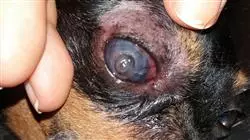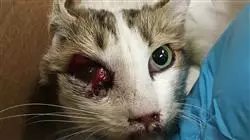University certificate
The world's largest faculty of veterinary medicine”
Why study at TECH?
An intensive education in the surgery of corneal, crystalline, uveal and retinal lesions and conditions in small animal ophthalmology"

The cornea is one of the most exposed and visible areas, and any alteration can be detected very quickly. Each corneal component heals to a different degree, at a different speed and by completely different mechanisms. Understanding these differences will help us to identify if the repair is occurring abnormally, in order to intervene early and improve the prognosis of our patients.
This Postgraduate diploma develops specialized knowledge about the different diagnostic methods and their indications and includes learning the basic and necessary instruments for a complete ophthalmological examination. The complete ophthalmological examination will be approached starting with the anamnesis, the clinical history of the patient up to the different procedures that can be used to reach a correct diagnosis. We examine the most important procedures, tests and devices that facilitate accurate diagnosis.
In addition, the keys will be presented so that the student can approach one of the most complex phases of the ophthalmological examination: the identification of changes in color, edges and visual "texture", and their association to each corneal pathology and clinical relevance.
For all these reasons, this is the most complete Postgraduate diploma that students will find in the market, and it also includes an online methodology that will allow them to learn from the comfort of the place of their choice, without schedules and without time limits. Through state-of-the-art audiovisual content, this revolutionary methodology will turn the graduate into an Expert in Eye Surgery in Small Animals.
A world-renowned expert will join this educational itinerary. TECH has invited a renowned veterinary ophthalmology researcher to serve as the International Guest Director of this program. Likewise, this specialist is responsible for teaching a series of comprehensive Masterclasses where the main therapeutic and surgical advances in animal eye diseases are covered.
The International Guest Director of this program will update you on the most cutting-edge corneal healing technique in animals”
This Postgraduate diploma in Corneal, Crystalline Lens, Uveal and Retinal Surgery in Small Animals contains the most complete and up-to-date scientific program on the market. The most important features include:
- The development of case studies presented by experts in Veterinary Ophthalmology
- The graphic, schematic, and practical contents with which they are created, provide scientific and practical information on the disciplines that are essential for professional practice
- Practical exercises where self-assessment can be used to improve learning
- Its special emphasis on innovative methodologies
- Theoretical lessons, questions to the expert, debate forums on controversial topics, and individual reflection assignments
- Content that is accessible from any fixed or portable device with an Internet connection
Stand out from other professionals with the ability to care for small animal eye diseases”
The program’s teaching staff includes professionals from the industry who contribute their work experience to this program, as well as renowned specialists from leading societies and prestigious universities.
The multimedia content, developed with the latest educational technology, will provide the professional with situated and contextual learning, i.e., a simulated environment that will provide immersive education programmed to prepare for real situations.
This program is designed around Problem-Based Learning, whereby the professional must try to solve the different professional practice situations that arise during the course. For this purpose, the students will be assisted by an innovative interactive video system created by renowned and experienced experts.
A process of total quality growth that will allow you to specialize in a field of great interest and demand"

With an intensive and efficient process, this Postgraduate diploma will lead students to acquire theoretical and practical knowledge quickly and in a way that is compatible with other obligations"
Syllabus
For this Postgraduate Diploma, a group of veterinary professionals of the highest level have designed the most complete and in-depth set of contents on the educational market. As a result, after enrolling in this program, the students will have a series of materials in multimedia format and with a practical theoretical approach that will help them learn everything they need to successfully practice as a veterinary ophthalmologist. A unique academic opportunity based on the best teaching methodology that will elevate the professionals to the top of their careers.

The drive for up-to-date, cutting edge education that will put your CV at the forefront of the labor market”
Module 1. Ophthalmological Examination and Complementary Tests
1.1. Ophthalmological Examination
1.1.1. Remote Ophthalmological Examination
1.1.2. Medical History
1.1.3. Clamping Methods
1.1.4. Basic Instruments for Ophthalmological Examination
1.2. Direct and Indirect Ophthalmoscopy
1.2.1. Direct Examination
1.2.1.1. Palpebral Reflex
1.2.1.2. Menace Response
1.2.1.3. Dazzle Reflex
1.2.1.4. Pupillary Light Reflex
1.2.1.5. Corneal Reflex
1.2.2. Biomicroscopy
1.2.3. Direct Ophthalmoscopy
1.2.4. Indirect Ophthalmoscopy
1.2.4.1. Monocular Indirect Ophthalmoscopy
1.3. Ophthalmical Examination Tests
1.3.1. Schirmer Test
1.3.2. Fluorescein Test
1.3.2.1. Fluorescein Test
1.3.2.2. Break Up Time (BUT)
1.3.2.3. Jones Test
1.3.2.4. Seidel Test
1.3.3. Rose Bengal
1.3.4. Lissamine Green
1.4. Tonometry
1.4.1. Indentation Tonometry
1.4.2. Applanation Tonometry
1.4.3. Rebound Tonometry
1.5. Gonioscopy
1.5.1. Direct Gonioscopy
1.5.2. Indirect Gonioscopy
1.6. Cytology and Biopsy
1.6.1. Cytology Sampling
1.6.1.1. Conjunctival Cytology
1.6.1.2. Corneal Cytology
1.6.1.3. Aqueous Humor Cytology
1.6.1.4. Vitreous Cytology
1.6.2. Biopsy Sampling
1.7. Ocular Ultrasound
1.7.1. Anterior Segment Ultrasound
1.7.2. Posterior Segment Ultrasound
1.7.3. Orbit Ultrasound
1.8. Optical Coherence Tomography (OCT)
1.8.1. Corneal OCT
1.8.2. Iridocorneal Angle
1.8.3. Retinal OCT
1.9. Electroretinography
1.9.1. Electroretinography (ERG)
1.9.2. Electroretinography Technique
1.9.3. ERG Applications
1.10. Other Diagnostic Imaging
1.10.1. MRI and CT
1.10.2. Fluorescein Angiography
1.10.3. Pachymetry
1.10.4. Meibography
Module 2. Corneal Diseases and Surgery
2.1. Physiology of the Cornea
2.1.1. Clarity. Corneal Transparency
2.1.2. Corneal Wound Healing
2.1.2.1. Proteases and Protease Inhibitors in the Corneal Wound Healing Process
2.1.2.2. Proteinases
2.1.3. Corneal Epithelial, Endothelial Pigmentation
2.1.4. Corneal Edema, Corneal Vascularization
2.2. Congenital and Developmental Diseases
2.2.1. Microcornea. Megalocornea
2.2.2. Dermoid Cysts
2.2.3. Congenital Opacities. Persistent Pupillary Membranes
2.2.4. Coloboma. Staphyloma
2.3. Inflammatory Keratopathies
2.3.1. Ulcerative Keratitis
2.3.2. Bacterial Keratitis
2.3.3. Viral Keratitis
2.3.4. Mycotic Keratitis
2.4. Corneal Ulcers
2.4.1. Ulcer Depth Identification
2.4.2. Spontaneous Chronic Corneal Epithelial Defects (SCCEDs)
2.5. Corneal Surgery
2.5.1. Corneal Adhesives
2.5.2. Conjunctival Tissue
2.5.3. Use of Biological Membranes
2.5.4. Keratoplasties
2.6. Non-Ulcerative Keratitis
2.6.1. Pigmentary Keratitis
2.6.2. Chronic Superficial Keratitis
2.6.3. Keratitis Punctata
2.6.4. Marginal Keratitis
2.6.5. Keratitis Punctata
2.6.6. Neurogenic Keratitis
2.7. Non-Inflammatory Keratopathies
2.7.1. Corneal Dystrophies
2.7.2. Lipid Keratopathy
2.7.3. Corneal Degeneration
2.7.4. Endothelial Dystrophy
2.7.5. Florida Keratopathy
2.7.6. Surgery for Keratopathies
2.8. Corneal Neoplasms
2.8.1. Neoplasms in Dogs
2.8.2. Neoplasms in Cats
2.9. Sclera
2.9.1. Structure and Function
2.9.2. Inflammatory Diseases
2.9.2.1. Episcleritis
2.9.2.1.1. Nodular Granulomatous
2.9.3. Scleritis
2.9.3.1. Non-Necrotizing
2.9.3.2. Necrotizing
2.9.4. Trauma. Laceration
2.10. Cross Linking. Cryotherapy
2.10.1. Cross Linking and Cryotherapy
2.10.2. Keratopathies Treated with Cross Linking
2.10.3. Keratopathies Treated with Cryotherapy
Module 3. Lens Diseases and Surgery
3.1. Embryology and Anatomy
3.1.1. Embryology
3.1.2. Anatomy
3.2. Crystalline Lens Examination
3.2.1. Crystalline Lens Examination
3.2.2. Advanced Examination
3.3. Congenital Disorders
3.3.1. Aphakia
3.3.2. Coloboma
3.3.3. Microphakia
3.3.4. Lenticonus
3.3.5. PHPV/TVL
3.3.6. Cataracts
3.4. Acquired Disorders
3.4.1. Cataracts, Classification
3.4.2. Characterization, Location
3.4.3. Age
3.4.3.1. Congenital
3.4.3.2. Hereditary
3.4.3.3. Aged Related
3.4.4. Primary vs. Secondary
3.5. Metabolic and Systemic Cataracts
3.5.1. Ions
3.5.2. Diabetes
3.5.3. Galactosemia
3.5.4. Infectious Diseases
3.6. Metabolic and Systemic Cataract Treatment
3.6.1. Medical
3.6.2. Surgical
3.7. Eye Disorders and Untreated Cataract Sequelae
3.7.1. Eye Disorders
3.7.2. Untreated Cataract Sequelae
3.7.2.1. Iris Hyperpigmentation
3.7.2.2. Other Sequelae
3.8. Dislocation
3.8.1. Primary Dislocation
3.8.2. Secondary Dislocation
3.9. Cataract Surgery
3.9.1. Patient Selection
3.9.2. Complementary Tests
3.9.2.1. Ultrasound
3.9.2.2. Gonioscopy
3.9.2.3. ERG
3.9.3. Complications
3.9.3.1. Preoperative
3.9.3.2. Intraoperative
3.9.3.3. Postoperative
3.9.4. Patient Preparation
3.9.5. Equipment
3.9.6. Surgery
3.10. Lens Luxation Surgery
3.10.1. Patient Choice
3.10.2. Patient Preparation
3.10.3. Intraoperative Complications
3.10.4. Techniques
Module 4. Uveal and Retinal Diseases and Surgery
4.1. Embryology and Anatomy of Uveal
4.1.1. Embryology
4.1.2. Anatomy
4.2. Congenital Disorders
4.2.1. Heterochromia
4.2.2. Coloboma
4.2.3. Persistent Pupillary Membranes
4.2.4. Dyscoria
4.3. Degenerative Disorders
4.3.1. Iris Atrophy
4.3.2. Iris Cysts
4.4. Uveal Inflammation
4.4.1. Intraocular Causes
4.4.2. Systemic Causes
4.5. Diagnosis and Clinical Introduction
4.5.1. Ophthalmological Examination
4.5.2. Neuro-Ophthalmology
4.6. Discoloration
4.6.1. Benign
4.6.2. Neoplasms
4.6.2.1. Primary
4.6.2.2. Metastatic
4.7. Specific Treatments Based on Cause
4.7.1. Topical Treatments
4.7.2. Adjuvant systemic therapy
4.7.3. Specific Therapy by Etiology
4.7.4. Sequelae Control
4.8. Variations in Ocular Fundus Normality
4.8.1. Age
4.8.2. Albinism
4.9. Retinal Disorders
4.9.1. On Development
4.9.2. Hereditary
4.9.3. Storage Related
4.9.4. Inflammatory (Causes)
4.9.5. Various
4.9.5.1. SARDs
4.9.5.2. CAR
4.9.5.3. Immune-Mediated Retinitis
4.9.5.4. Uveodermatologic Syndrome
4.9.5.5. Nutritional
4.9.5.6. Neoplasms
4.10. Medical Management vs. Surgical Retinal Lesions
4.10.1 Types of Retinal Detachment
4.10.2 Genetic Disorders

A complete and efficient program that will be tailored to your needs and expectations"
Postgraduate Diploma in Cornea, Lens, Uvea and Retina Surgery in Small Animals
Corneal, lens, uveal and retinal surgery in small animals refers to a series of surgical procedures performed on the ocular structures of pets, such as dogs, cats or other small animals. Corneal surgery is performed to correct a variety of conditions, such as corneal ulcers, wounds, congenital defects, scarring or deformities. Corneal surgery procedures may include suturing or wetting the cornea to repair an injury, or removing diseased corneal tissue to treat diseases such as keratoconus. Crystalline lens surgery is used to correct cataracts, an opacity of the lens that can affect the animal's vision. The surgical procedure usually involves removing the diseased lens and replacing it with an intraocular lens to restore the animal's vision. Uveal surgery is performed to treat diseases of the uvea, the vascular layer that lies between the retina and the sclera of the eye. Uveal surgery procedures may include correction of retinal detachments or treatment of inflammation or tumors in the region of the uvea. Retinal surgery is performed to treat a variety of conditions, such as retinal detachments, macular holes, tumors or inflammation. Surgical procedures on the retina may include removal of diseased tissue or insertion of a prosthetic device to correct eye diseases or defects.
TECH, the world's largest online university, has the Postgraduate Diploma in Cornea, Lens, Uvea and Retina Surgery in Small Animals academic program, delivered completely online and designed to provide students with a thorough and comprehensive understanding of ocular anatomy in small animals, as well as specialized surgical techniques for the treatment of ocular diseases in the areas of the cornea, lens, uvea and retina. Students learn to diagnose and treat a wide variety of ocular conditions, and develop specialized clinical skills in small animal ophthalmic surgery.







